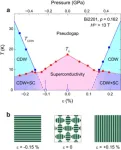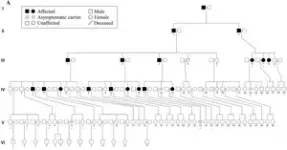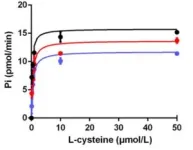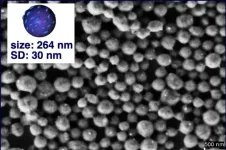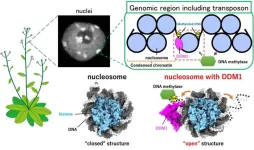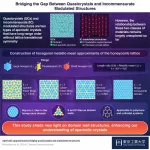(Press-News.org)
Superconductors are materials that can conduct electricity with zero resistance when cooled to a certain temperature, called the critical temperature. They have applications in many fields, including power grids, maglev trains, and medical imaging. High-temperature superconductors, which have critical temperatures higher than normal superconductors have significant potential for advancing these technologies. However, the mechanisms behind their superconductivity remain unclear.
Copper oxides or cuprates, a class of high-temperature superconductors, exhibit superconductivity when electrons and holes (vacant spaces left behind by electrons) are introduced into their crystal structure through a process called doping. Interestingly, in the low-doped state, with less-than-optimal electrons required for superconductivity, a pseudogap –a partial gap in the electronic structure– opens. This pseudogap is considered a potential factor in the origin of superconductivity in these materials.
Additionally, previous studies have revealed a long-range charge density wave (CDW) order, in the low-doped regime of cuprates that breaks the crystal symmetry of the copper oxide (CuO2) plane. CDW is a repeating wave-like pattern of electrons that affects the material's conductivity. This symmetry breaking is significant as superconductivity has been known to arise inside or near symmetry-broken states. Moreover, in the bismuth-based cuprate superconductor, Bi2Sr2-xLaxCuO6+δ (Bi2201), it has been shown that strong magnetic fields can induce a long-range symmetry-breaking CDW order. Despite extensive research, the exact role of these phenomena in the occurrence of superconductivity in cuprates is still not known.
In a new study, a team of researchers led by Associate Professor Shinji Kawasaki from the Department of Physics at Okayama University, Japan investigated the origin of high-temperature superconductivity in the pseudogap state of cuprates using a novel approach. Prof. Kawasaki explains, “In this study, we have discovered the existence of a long-range CDW order in the optimally doped Bi2201, induced by tensile-compressive strain applied by a novel piezo-driven uniaxial strain cell, which deliberately breaks crystal symmetry of the CuO2 plane.” Their findings were published in the journal Nature Communications on June 14, 2024. The team included Ms. Nao Tsukuda and Professor Guo-qing Zheng, also from Okayama University, and Dr. Chengtian Lin from Max-Planck-Institut fur Festkorperforschung, Germany.
The researchers used nuclear magnetic resonance (NMR) technique to observe the changes in the electronic structure of the optimally doped Bi2201 superconductor as uniaxial compressive and tensile strains were applied to the material. The results revealed that when the strain exceeded 0.15%, the material underwent a significant transformation, with the short-range CDW order transitioning into a long-range CDW order. Furthermore, increasing strain suppressed superconductivity while enhancing CDW order, indicating that both superconductivity and long-range CDW can coexist. These results suggest that a hidden long-range CDW order, not limited to the low-doped regime, exists in the pseudogap state of cuprates, which becomes apparent under strain.
“This finding challenges the conventional belief that magnetism is the primary driver in copper oxides and provides valuable insights for constructing theoretical models of superconductivity, “remarks Prof. Kawasaki. Highlighting the potential applications of this study, he adds, “The findings of this study hold immense promise for elucidating the underlying mechanisms of high-temperature superconductivity, paving the way for the development of more practical superconducting materials. High temperature superconductors hold great potential for lossless power transmission and storage, contributing significantly to energy conservation and the pursuit of carbon neutrality. Furthermore, the application of superconductors in MRI technology has the potential to reduce costs and make advanced medical imaging more accessible.”
Overall, this study marks a significant step towards understanding the origin of high-temperature superconductivity, highlighting the importance of uniaxial strain as a valuable tool for understanding superconductivity in other similar superconductors.
About Okayama University, Japan
As one of the leading universities in Japan, Okayama University aims to create and establish a new paradigm for the sustainable development of the world. Okayama University offers a wide range of academic fields, which become the basis of the integrated graduate schools. This not only allows us to conduct the most advanced and up-to-date research, but also provides an enriching educational experience.
Website: https://www.okayama-u.ac.jp/index_e.html
About Associate Professor Shinji Kawasaki from Okayama University, Japan
Shinji Kawasaki is currently an Associate Professor at the Faculty of Science, Department of Physics at Okayama University. He obtained his M.S. and Ph.D. degrees from Osaka University in 2001 and 2004, respectively. He has over 100 publications with over 2000 citations. Before joining Okayama University in 2006, he served as a research fellow of the Japan Society for the Promotion of Science of Japan Science (DC2, PD) and as a specially appointed assistant at the Center of Excellence of Osaka University. His research interests include magnetism, superconductivity, and strongly correlated electron systems.
END
Scientists have taken a significant step towards the development of tailor-made chiral nanocarriers with controllable release properties. These nanocarriers, inspired by nature's helical molecules like DNA and proteins, hold immense potential for targeted drug delivery and other biomedical applications.
The study, led by Professors Emilio Quiñoá and Félix Freire at the Center for Research in Biological Chemistry and Molecular Materials (CiQUS), highlights the intricate relationship between the structure of helical polymers and their self-assembly into nanospheres. By carefully designing ...
The grants – each worth €150,000 – help researchers to bridge the gap between the discoveries stemming from their frontier research and the practical application of the findings, including early phases of their commercialisation.
Nanda Rea’s new project, called DeepSpacePULSE, aims to facilitate deep space exploration. Currently, to find their way, spacecraft and satellites use up a lot of energy exchanging vital navigation information with mission coordinators on Earth. Using ERC Proof of Concept funding, Prof. Nanda Rea ...
Native plants and non-native crops do not fare well in proximity to one another, attracting pests that spread diseases in both directions, according to two new UC Riverside studies.
“We have changed the landscape, and it’s created opportunities for pathogens to thrive,” said UCR entomologist Kerry Mauck, who co-authored the studies. “We have introduced pathogens that damage native plants, and on the other side of the coin we have endemic pathogens that mutate to infect ...
PULLMAN, Wash. – A small 3-ounce sensor capable of recording 2,400 data points of movement in just one second being tested and refined by researchers at Washington State University could be key in reducing the number of injuries to racehorses.
Led by Dr. Warwick Bayly in WSU’s College of Veterinary Medicine, researchers used the biometric sensors, developed by the company StrideSAFE, to track thoroughbreds as they raced and trained at some of the top racetracks in the country. Using collected data, the team was able to identify miniscule stride changes associated with increased risk ...
International joint research led by Akihisa Osakabe and Yoshimasa Takizawa of the University of Tokyo has clarified the molecular mechanisms in thale cresses (Arabidopsis thaliana) by which the DDM1 (Decreased in DNA Methylation 1) protein prevents the transcription of “jumping genes.” DDM1 makes “jumping genes” more accessible for transcription-suppressing chemical marks to be deposited. Because a variant of this protein exists in humans, the discovery provides insight into genetic conditions caused by such “jumping gene” mutations. The findings ...
Switching from a diet high in saturated animal fats to one rich in plant-based unsaturated fats affects the fat composition in the blood, which in turn influences long-term disease risk. A recent study published in Nature Medicine, conducted by a team of researchers from Chalmers University of Technology, Sweden, the German Institute of Human Nutrition, Germany and several other universities, shows that it is possible to accurately measure diet-related fat changes in the blood and directly link them to the risk of developing cardiovascular disease and type 2 diabetes.
“Our study confirms with even more certainty the health benefits of ...
Bees and other beneficial bugs are disproportionately harmed by air pollution compared to crop-destroying pests, a new study published in Nature Communications has found.
Researchers from the University of Reading analysed data from 120 scientific papers to understand how 40 types of insects in 19 countries respond to air pollutants like ozone, nitrogen oxides, sulfur dioxide and particulate matter. Pollinators - including bees and some moths and butterflies - experienced a 39% decline in foraging ...
For a long time, scientists associated crystal structures with an ordered arrangement of atoms in a repeating lattice-like pattern, believing it to be the most stable configuration. However, by the 1960s, advancements in crystallography revealed materials that did not fit the traditional model. These structures exhibit a non-periodic or non-repeating pattern and are called aperiodic crystals.
There are two types of aperiodic crystals: quasicrystals (QCs), which exhibit ordered but aperiodic arrangements, and incommensurately (IC) modulated structures, where a three-dimensional periodic lattice structure ...
The possibility of hydrogen-powered flight means greater opportunities for fossil-free travel, and the technological advances to make this happen are moving fast. New studies from Chalmers University of Technology, in Sweden, show that almost all air travel within a 750-mile radius (1200 km) could be made with hydrogen-powered aircraft by 2045, and with a novel heat exchanger currently in development, this range could be even further.
“If everything falls into place, the commercialisation of hydrogen flight can go really fast now. As early as 2028, the first commercial hydrogen flights in Sweden could be in the air," says Tomas Grönstedt, Professor at Chalmers ...
Some people lose weight slower than others after workouts, and a Kobe University research team found a reason. They studied what happens to mice that cannot produce signal molecules that respond specifically to short-term exercise and regulate the body’s energy metabolism. These mice consume less oxygen during workouts, burn less fat and are thus also more susceptible to gaining weight. Since the team found this connection also in humans, the newly gained knowledge of this mechanism might provide a pathway for treating obesity.
It is well known that exercise leads to the ...
